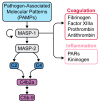Targeting the Complement Cascade in the Pathophysiology of COVID-19 Disease
- PMID: 34069355
- PMCID: PMC8158769
- DOI: 10.3390/jcm10102188
Targeting the Complement Cascade in the Pathophysiology of COVID-19 Disease
Abstract
Severe coronavirus disease 2019 causes multi-organ dysfunction with significant morbidity and mortality. Mounting evidence implicates maladaptive over-activation of innate immune pathways such as the complement cascade as well as endothelial dysfunction as significant contributors to disease progression. We review the complement pathways, the effects of severe acute respiratory syndrome coronavirus 2 (SARS-CoV-2) on these pathways, and promising therapeutic targets in clinical trials.
Keywords: COVID-19; SARS-CoV-2; complement inhibitor; complement pathway; lectin pathway; mannose-associated serine protease inhibitor.
Conflict of interest statement
C.A.P. is supported by an NIH grant (5R01HL130826) and is the principal investigator at the Mount Sinai Hospital for the expanded access program of eculizumab (NCT04355494) and the phase III clinical trial of ravulizumab (NCT04570397) in severe COVID-19. N.N. is a co-investigator for both studies. The funders had no role in the design of the study; in the collection, analyses, or interpretation of data; in the writing of the manuscript, or in the decision to publish the results.
Figures




Similar articles
-
Targeting complement cascade: an alternative strategy for COVID-19.3 Biotech. 2020 Nov;10(11):479. doi: 10.1007/s13205-020-02464-2. Epub 2020 Oct 19. 3 Biotech. 2020. PMID: 33088671 Free PMC article. Review.
-
Complement lectin pathway activation is associated with COVID-19 disease severity, independent of MBL2 genotype subgroups.Front Immunol. 2023 Mar 27;14:1162171. doi: 10.3389/fimmu.2023.1162171. eCollection 2023. Front Immunol. 2023. PMID: 37051252 Free PMC article.
-
Complement cascade in severe forms of COVID-19: Recent advances in therapy.Eur J Immunol. 2021 Jul;51(7):1652-1659. doi: 10.1002/eji.202048959. Epub 2021 Apr 10. Eur J Immunol. 2021. PMID: 33738806 Free PMC article. Review.
-
Complement Activation Contributes to Severe Acute Respiratory Syndrome Coronavirus Pathogenesis.mBio. 2018 Oct 9;9(5):e01753-18. doi: 10.1128/mBio.01753-18. mBio. 2018. PMID: 30301856 Free PMC article.
-
Highly pathogenic coronavirus N protein aggravates inflammation by MASP-2-mediated lectin complement pathway overactivation.Signal Transduct Target Ther. 2022 Sep 14;7(1):318. doi: 10.1038/s41392-022-01133-5. Signal Transduct Target Ther. 2022. PMID: 36100602 Free PMC article.
Cited by
-
Systemic Inflammation and Complement Activation Parameters Predict Clinical Outcome of Severe SARS-CoV-2 Infections.Viruses. 2021 Nov 26;13(12):2376. doi: 10.3390/v13122376. Viruses. 2021. PMID: 34960645 Free PMC article.
-
Modelling and analysis of the complement system signalling pathways: roles of C3, C5a and pro-inflammatory cytokines in SARS-CoV-2 infection.PeerJ. 2023 Sep 20;11:e15794. doi: 10.7717/peerj.15794. eCollection 2023. PeerJ. 2023. PMID: 37744234 Free PMC article.
-
What we know and still ignore on COVID-19 immune pathogenesis and a proposal based on the experience of allergic disorders.Allergy. 2022 Apr;77(4):1114-1128. doi: 10.1111/all.15112. Epub 2021 Oct 12. Allergy. 2022. PMID: 34582050 Free PMC article. Review.
-
Distinct protein patterns related to postnatal development in small for gestational age preterm infants.Pediatr Res. 2025 Apr;97(5):1722-1731. doi: 10.1038/s41390-024-03481-0. Epub 2024 Aug 16. Pediatr Res. 2025. PMID: 39152333 Free PMC article.
-
Complement and endothelial cell activation in COVID-19 patients compared to controls with suspected SARS-CoV-2 infection: A prospective cohort study.Front Immunol. 2022 Sep 20;13:941742. doi: 10.3389/fimmu.2022.941742. eCollection 2022. Front Immunol. 2022. PMID: 36203596 Free PMC article.
References
-
- Chaplin H. Review: The burgeoning history of the complement system 1888–2005. Immunohematology. 2005;21:85–93. - PubMed
Publication types
Grants and funding
LinkOut - more resources
Full Text Sources
Other Literature Sources
Miscellaneous

